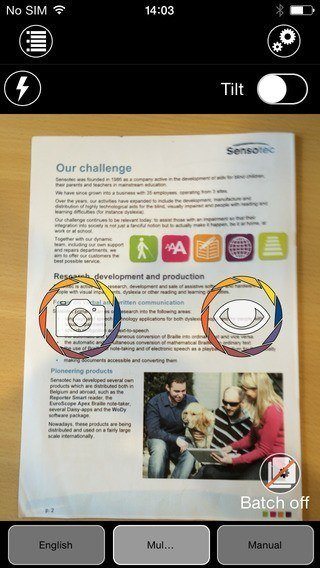KNFB Reader App: Sight for People with Vision Disability
Author: Thomas C. Weiss
Published: 2014/09/22 - Updated: 2025/01/07
Publication Type: Product Release, Update
Category Topic: Disability Apps - Academic Publications
Page Content: Synopsis - Introduction - Main
Synopsis: App allows people who are blind to listen to audio, read back printed text from menus in restaurants, to browsing handouts in the classroom. The app that allows people who are blind to listen to an audio read-back of printed text is receiving rave reviews after its first day of availability and is being heralded as a life-changer
Introduction
Jonathan Mosen, who has been blind since birth, spent his evening snapping photos of packages in the mail, his son's school report and labels on bottles in the fridge. In seconds, he was listening to audio of the printed words the camera captured, courtesy of a new app on his Apple Inc iPhone.
Main Content
"I couldn't believe how accurate it was," said Mosen, an assistive technology consultant from New Zealand.
The new app that allows people who are blind to listen to an audio read-back of printed text is receiving rave reviews after its first day of availability and is being heralded as a life-changer by many people. People with vision disabilities say the KNFB Reader app will enable a new level of engagement in everyday life, from reading menus in restaurants to browsing handouts in the classroom. The app is the result of a four decades-long relationship between the National Federation of the Blind and Ray Kurzweil, a well-known artificial-intelligence scientist and senior Google employee.

According to its website, K-NFB Reading Technology Inc and Sensotec NV, a Belgium-based company, led the technical development of the app. Kurzweil, who demonstrated the app on stage at the NFB's annual convention in June, said it can replace a "sighted adviser ". Taking advantage of new pattern recognition and image- processing technology as well as new smartphone hardware, the app allows users to adjust or tilt the camera, and reads printed materials out loud.
People with refreshable Braille displays can now snap pictures of print documents and display them in Braille near-instantaneously, said NFB spokesman Chris Danielsen. The app has already given some people greater independence, users said on Thursday and Friday on social-media sites such as Twitter. One early adopter, Gordon Luke, tweeted that he was able to use the app to read his polling card for the Scottish Referendum.
The app will be available on Android in the coming months, Kurzweil told Reuters in an interview. He may also explore a version of the app for Google Glass, a postage stamp-sized computer screen that attaches to eyeglass frames and is capable of taking photos, recording video and playing sound.
"Google Glass makes sense because you direct the camera with your head," Kurzweil said.
Kurzweil started working on so-called "reading machines" in the early 1970s after chatting on a plane with a blind person who voiced frustrations with the lack of optical-recognition technology on the market. A few years later, "Kurzweil burst into the National Federation of the Blind's offices in Washington, DC, and said he had invented a reading machine," recalled Jim Gashel, a former NFB employee who currently heads business development at KNFB Reader. "It was phenomenal."
Kurzweil's first reading machine was the size of a washing machine and cost $50,000.
The technology has continued to improve over the past few decades - the new smartphone app can recognize and translate print between different languages and scan PowerPoint slides up to 7.6m away - but it was not available on a mainstream mobile device until now. Previously, it cost more than US$1,000 to use the software with a Nokia cell phone and a camera.
San Francisco-based Bryan Bashin, executive director of the non-profit Lighthouse for the Blind and Visually Impaired, said the KNFB app shows the positive and profound impact that technology can have.
"There are innumerable times in life that I'll have a bit of print and there will be nobody around who can help me out, and I'll just want to know something as simple as 'Is this packet decaf or caffeinated coffee'" Bashin said. "The ability to do this easily with something that fits in your pocket at lightning speed will certainly be a game changer."
 Author Credentials: Thomas C. Weiss is a researcher and editor for Disabled World. Thomas attended college and university courses earning a Masters, Bachelors and two Associate degrees, as well as pursing Disability Studies. As a CNA Thomas has providing care for people with all forms of disabilities. Explore Thomas' complete biography for comprehensive insights into his background, expertise, and accomplishments.
Author Credentials: Thomas C. Weiss is a researcher and editor for Disabled World. Thomas attended college and university courses earning a Masters, Bachelors and two Associate degrees, as well as pursing Disability Studies. As a CNA Thomas has providing care for people with all forms of disabilities. Explore Thomas' complete biography for comprehensive insights into his background, expertise, and accomplishments.